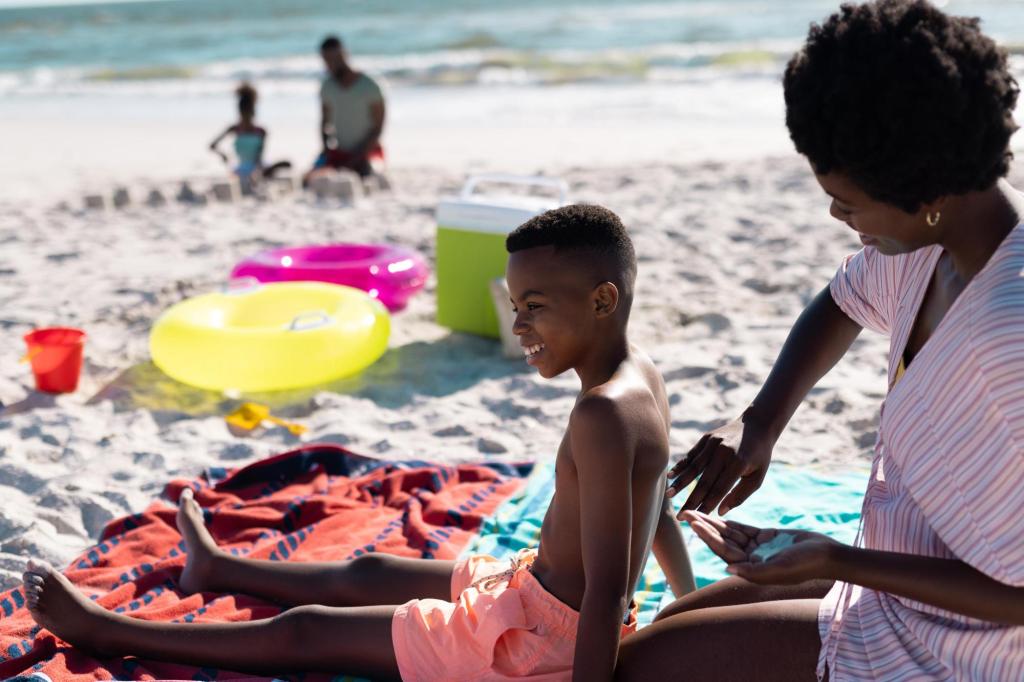
As summer beckons and children head outdoors to play, it’s important to protect them from too much sun and heat as well as air pollution, especially on days when the air quality is poor.
Families are encouraged to check the local daily Air Quality Index to identify when air pollution, wildfires and heat raise the risks of asthma and other health concerns.
It’s great to see children enjoying nature and reaping the benefits of outdoor activities. But as we encounter more intense weather events, including severe heat, families can use some layers of protection that families to help their kids stay healthy.
Sunburn and UV rays are one concern. Sun and heat can also worsen local air pollution by contributing to ozone and smog.
Here are some tips to ensure a safe and fun summer for everyone:
— Babies under 6 months of age should be kept out of direct sunlight. Move your baby to the shade under a tree, umbrella or stroller canopy. Dress babies in lightweight clothing that covers the arms and legs, and use brimmed hats that shade the neck to prevent sunburn.
— For older children, the first (and best) line of defense against harmful ultraviolet radiation exposure is covering up. Stay in the shade whenever possible, and limit sun exposure during the peak intensity hours: between 10 a.m. and 4 p.m. The sun’s damaging UV rays can bounce back from sand, water, snow or concrete, so be particularly careful of these areas.
— Select clothes made of tightly woven fabrics. Cotton clothing is both cool and protective. Try to find a wide-brimmed hat that can shade the cheeks, chin, ears and back of the neck. Sunglasses with ultraviolet (UV) protection are also a good idea for protecting your child’s eyes.
— Apply sunscreen with an SPF 15 or greater to areas of your child’s skin that aren’t covered by clothing. Put sunscreen on 15 to 30 minutes before going outdoors, as it needs time to absorb into the skin. Reapply every two hours after swimming, sweating or toweling off. The additional benefits of using sunscreen with SPF 50+ are limited. It’s OK to use sunscreen on young babies on small parts of their skin not protected by clothing or hats, but remember that babies touch their mouths a lot, and it’s best to prevent them from ingesting sunscreen in this way.
— When choosing a sunscreen, look for a water-resistant product and for the words “broad-spectrum” on the label — it means the sunscreen will protect against both ultraviolet B (UVB) and ultraviolet A (UVA) rays. Try to find products that contain the mineral ingredients zinc oxide or titanium dioxide. If possible, avoid the ingredient oxybenzone, a sunscreen chemical that may have hormonal properties.
Climate change is contributing to more intense summer heat. Extreme heat and air pollution affect everyone, but especially children. Children breathe faster and breathe more air compared to their body weight than adults. They breathe lower to the ground where some pollution settles. Children and adolescents are at increased risk of heat-related illness when they play, exercise or work outside, especially during summer months. Young children, especially, depend upon their parents and caregivers to protect them from extreme heat.
High levels of air pollution can cause asthma flare-ups, breathing trouble and other illnesses in children. For decades, some communities have lived with higher levels of pollution and heat. The effects of former laws and policies that discriminated against Black communities and communities of color are still felt by many children. Redlining is one example of a policy from the 1930s that resulted in more polluting and heat-trapping industry and infrastructure in predominantly Black neighborhoods. In the summer, children in communities that were redlined are exposed to more pollution, heat-trapping asphalt and higher temperatures. Many families may not have access to resources to cope with these intensified summer challenges.
To protect children against summer pollution, pollen and heat illnesses:
— Check your local Air Quality Index. Adjust your child’s outdoor activities when needed.
— If your child has asthma, ask your pediatrician how air pollution can be added to your child’s asthma action plan.
— Find out about your school’s guidelines for heat and outdoor play and make sure the school follows these guidelines.
— On hot days, make sure your child dresses appropriately, takes breaks, drinks plenty of water and takes time to get used to the temperature.
— If your child takes medication, ask your pediatrician if it increases your child’s risk for heat illness.
— Use MERV 13 rating or higher filters in your home’s central heating and cooling system, if possible.
— Use public transportation or choose walking and biking when it is safe to do so, consider a zero-emissions vehicle when you purchase your next car, or ask your school to switch to electric school buses.
— Advocate in your community for access to green space for all children and plant trees or participate in tree-planting service events to reduce urban heat effect and clean the air.
—
ABOUT THE WRITERS
Rebecca Philipsborn, MD, MPA, FAAP, is a pediatrician at Emory University and Children’s Healthcare of Atlanta and serves on the Southeast Pediatric Environmental Health Specialty Unit. She is a member of the Executive Committee of the American Academy of Pediatrics Council on Environmental Health and Climate Change and assistant editor of the upcoming fifth edition of Pediatric Environmental Health, the AAP handbook for pediatricians.
Sophie J. Balk, MD, FAAP, a general pediatrician at the Children’s Hospital at Montefiore in Bronx, New York, is a member of the AAP Executive Committee of the Council on Environmental Health and Climate Change. Dr. Balk is associate editor of the fourth edition and upcoming fifth edition of Pediatric Environmental Health.
©2023 Tribune Content Agency, LLC.
𝗖𝗿𝗲𝗱𝗶𝘁𝘀, 𝗖𝗼𝗽𝘆𝗿𝗶𝗴𝗵𝘁 & 𝗖𝗼𝘂𝗿𝘁𝗲𝘀𝘆: www.mercurynews.com
𝗙𝗼𝗿 𝗮𝗻𝘆 𝗰𝗼𝗺𝗽𝗹𝗮𝗶𝗻𝘁𝘀 𝗿𝗲𝗴𝗮𝗿𝗱𝗶𝗻𝗴 𝗗𝗠𝗖𝗔,
𝗣𝗹𝗲𝗮𝘀𝗲 𝘀𝗲𝗻𝗱 𝘂𝘀 𝗮𝗻 𝗲𝗺𝗮𝗶𝗹 𝗮𝘁 dmca@enspirers.com


